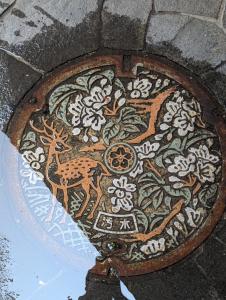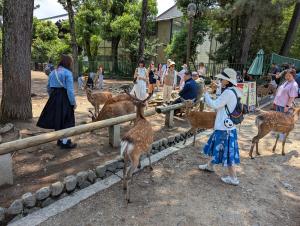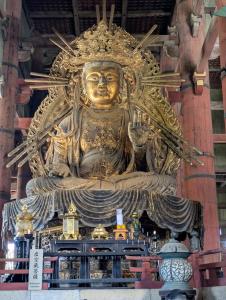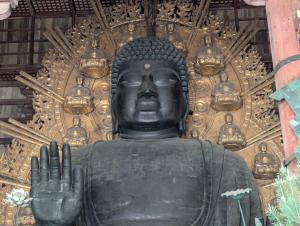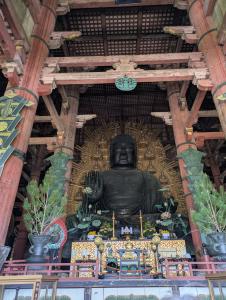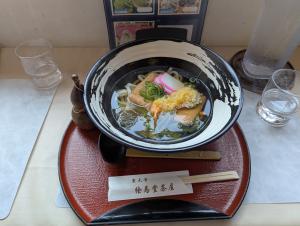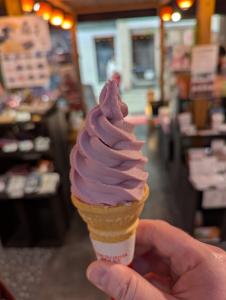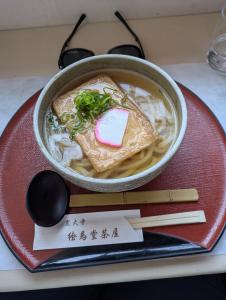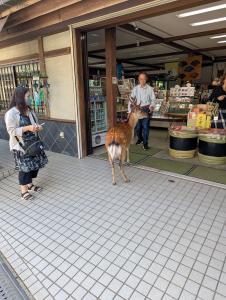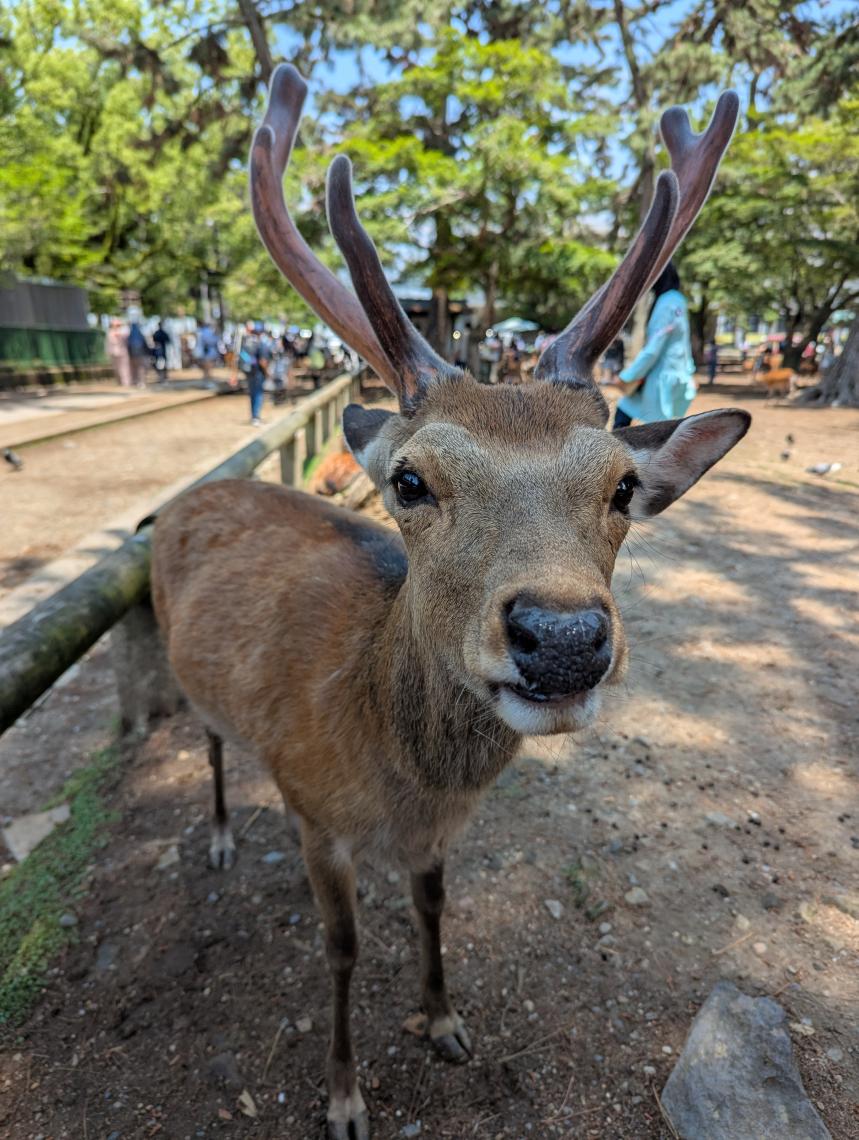
Day 17 - Please Feed the Deer
Nara
Prior to setting out this morning for Nara, we forwarded our bags to our Tokyo hotel using the Yamato Black Cat delivery service. For ~$35 our bags will be waiting for us in our room tomorrow afternoon upon our arrival. It means we can travel without them through busy train stations as we transfer one last time. But first, Nara . . .
Before Kyoto and Tokyo, there was Nara, Japan’s first permanent capital. Nara was Japan’s first permanent capital starting in 710, ending a tradition whereby the imperial court relocated each time an emperor died. The Nara period was hugely influential, absorbing influences from China, in particular Buddhism, and laying the foundations of Japanese culture. However, its reign lasted just 75 years. The rapid ascendance of Nara’s Buddhist establishment spooked the imperial government, and so the capital was moved to Kyoto, which in turn spared Nara from the destructive wars of later centuries.
Today travellers visit Nara on a day trip from Osaka or Kyoto, just enough time to breeze through the main attractions. For us these included the awesome Daibutsu (Great Buddha), resplendent inside one of the world’s largest wooden halls and Nara’s free-roaming deer.
We took an hour-long rapid express train to Nara from Osaka. There's no denying how diverse the Japanese countryside truly is. You almost instantly go from a major metropolitan area to small little hamlets dotted with rice fields. Out in the countryside there is no difference between agricultural land and a town, it's all mixed together.
We took the better part of the day for a 6km walk taking in the main sights of Nara. From Nara Station we visited Kofuku-ji Temple’s collection of great halls, Isui-en, savoured the poetic beauty of strolling the garden, and Tōdai-ji Temple. Along the way we found Nara's top sight attraction - some of the 1200 or so silka deer, who, despite the rarefied grandeur of the realm they inhabit, are basically the main attraction for most travellers. In fact, the deer themselves are designated a natural treasure, and boy do they know it. Unerringly tame, some have learned to bow in return for shika-sembei, a cracker mix of wheat flour and rice bran, while others – the pushier treasures – tug and nibble at your clothes (we both nearly lost clothing to these guys). The free-roaming deer are sacred to Kasuga-taisha, a shrine in the east of the park. One of the deities enshrined there is said to have ridden to Nara upon a sacred white deer, and ever since the deer of Nara have been protected as helpers of the gods. Though perhaps not divine, they are special – scientists have discovered Nara Park’s deer possess a unique genotype not seen in other herds, reflecting their thousand-plus years of protection. Lisa still argues that because their cousins eat her hostas, she doesn't have to feed them crackers. Jon was more magnanimous.
Leaving the deer, we followed the throngs marching to Daibutsu-den to pay homage to Daibutsu (Great Buddha), who's been holding court for more than 1250 years. Daibutsu (Great Buddha) sits just over 16m high and consists of 437 tonnes of bronze and 130kg of gold. Unveiled by Emperor Shōmu in 752 exactly 200 years after Buddhism first came to Japan, it was the biggest Buddhist statue anywhere, and it needed a suitably impressive building to house it. Daibutsu-den (Hall of the Great Buddha) is one of the world’s largest all-wood buildings, even though the current structure (circa 1709) is two-thirds the size of the original, which was gutted by fire in the 12th century.
After paying our respects to the Buddha of all Buddhas, we headed up the hill to Nigatsu-dō for its views across Nara plain and to have a peek at the adjacent Hokke-dō, the oldest building in the Tōdai-ji temple complex.
At this point we stopped for lunch of hot kitsune udon, udon noodle soup with seasoned fried tofu skin, and finished it off with two soft serve ice cream cones - cookies & cream and white peach. Taking the path running south we passed the grassy slopes of Wakakusa-yama and down a set of steps towards the forest.
We exited Nara Park and made our way towards Machiidonocho shopping street. We stopped by Nakatanidou, a sweet mochi shop iconic for making mochi by hand in their shop window where you can see the mochi masters rapidly pounding the sticky rice with a wooden mallet. Unfortunately, by the time we got there the mochi-making was over for the day, but we were still able to purchase a couple of their sweet mochi, made green with matcha powder, filled with sweet red bean paste, and dusted in sweet toasted soybean powder.
After catching the same rapid express bus back to Osaka Station, we headed up to the 8th floor of a nearby shopping building in Osaka Station City for an okonomiyaki restaurant we walked by a couple days ago that we had remembered. Unfortunately, this was another not so great restaurant experience while in Osaka. The savory pancake was quite different from what we were used to. It was very gooey inside, and we missed that it had key ingredients for this style - a layer of egg on the top, something Lisa would have rather opted out. Not that this style was necessarily bad, but it was a matter of expectations and had we known ahead of time what we were getting we would have opted for another shop.
Tomorrow we pack up our backpacks with our remaining essentials, check out of our Osaka hotel, and then head to our final hotel in Tokyo for two nights before returning home.
Points earned today!
| L | Activity | J |
|---|---|---|
| 3 | Adventurous Eater | 3 |
| 6 | Foodie (Unique foods) | 6 |
| 1 | Donations | |
| 1 | Nature Panorama | |
| 3 | Nature Panorama Award | |
| 7 | Souvenir: Food | 5 |
| 9 | Souvenir Set Complete | |
| Souvenir: Small Items | 1 | |
| Historical Panorama | 1 | |
| Historical Panorama Award | 3 |
